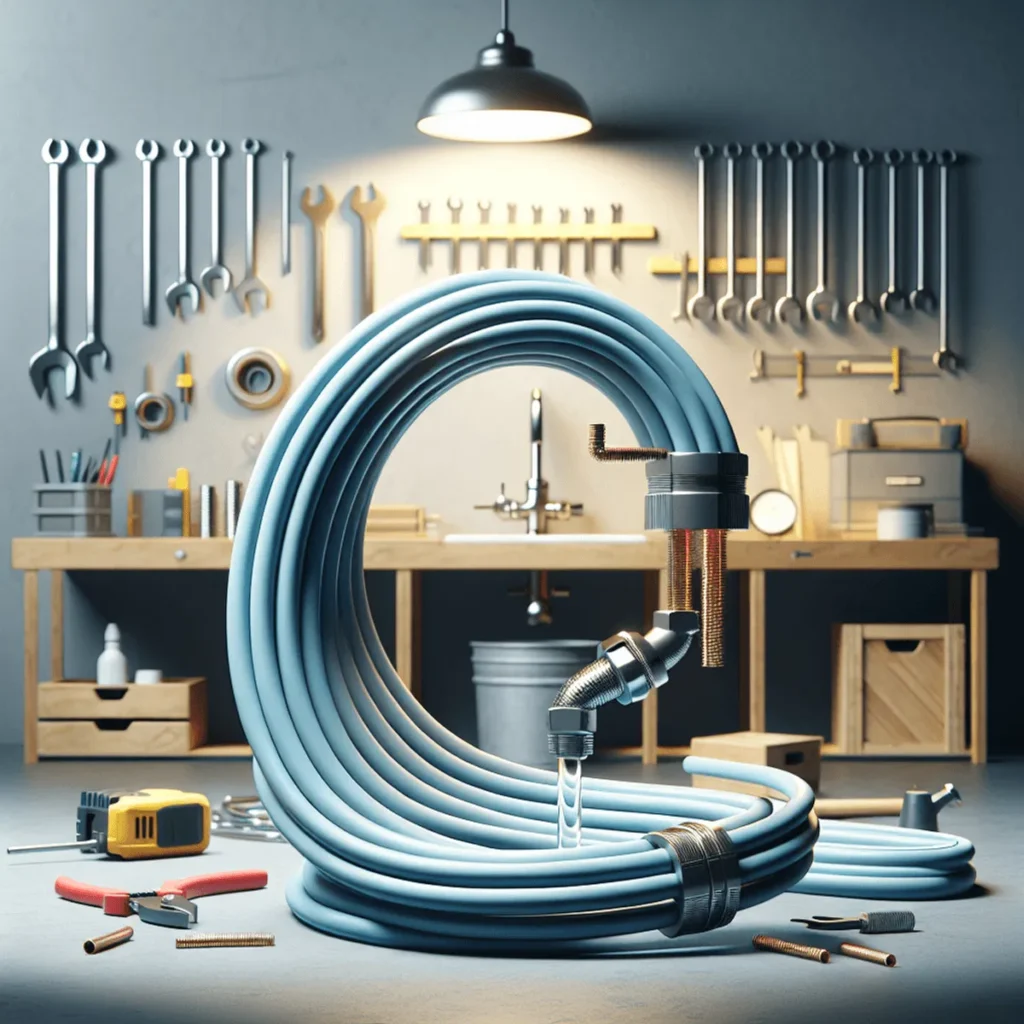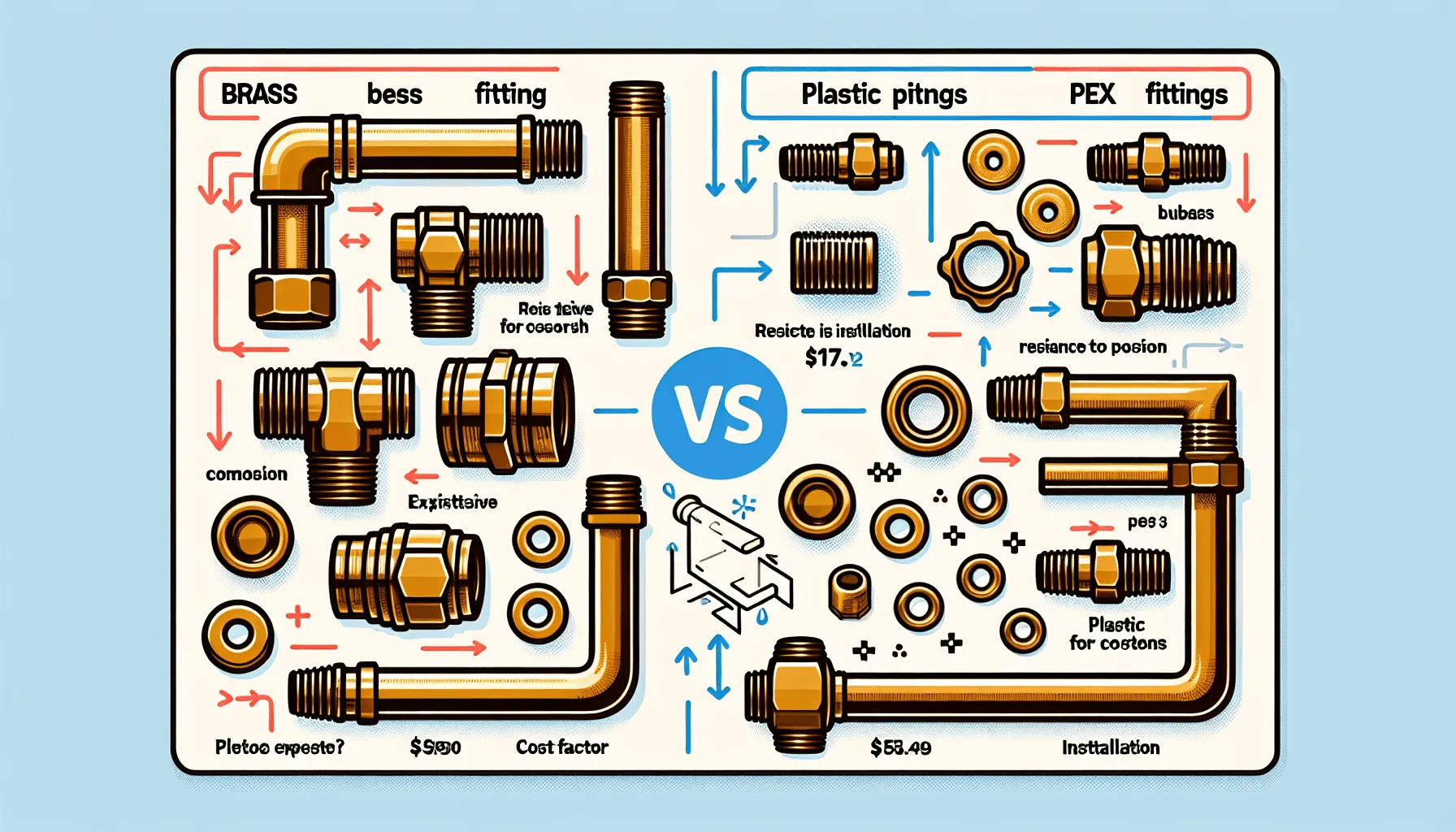Choosing the right PEX fittings is crucial for ensuring a reliable plumbing system. PEX, or cross-linked polyethylene, is a type of plastic tubing widely used in modern plumbing due to its flexibility and durability. These fittings connect sections of PEX tubing and come in various materials, predominantly brass and plastic.
Selecting the appropriate fitting material is extremely important. The wrong choice can lead to leaks, corrosion, and system failures, resulting in costly repairs. Understanding the differences between brass fittings and plastic fittings helps in making an informed decision that aligns with your specific needs.
The debate between brass and plastic fittings revolves around several factors:
- Strength and Durability: Brass fittings are celebrated for their robustness, while plastic fittings offer resistance to corrosion.
- Cost: Plastic fittings are generally more affordable compared to brass.
- Installation: Plastic fittings are easier to install, though they may present challenges in certain conditions.
By examining the pros and cons of each material, you can determine which option suits your project best.
Understanding PEX Fittings
PEX fittings, or cross-linked polyethylene fittings, are essential components in modern plumbing systems. These fittings connect PEX tubing, which has become a popular choice due to its flexibility, durability, and ease of installation.
Benefits of Using PEX in Plumbing Systems

- Flexibility: PEX tubing can bend around corners without the need for additional fittings.
- Durability: Resistant to scale and chlorine, reducing long-term maintenance.
- Cost-Efficiency: Lower material and labor costs compared to traditional copper or PVC piping.
- Reduced Noise: Quieter water flow due to the flexible nature of the material.
Types of PEX
1. PEX-A:
- Highest flexibility and freeze resistance.
- Suitable for both hot and cold water applications.
- Ideal for use in radiant heating systems.
2. PEX-B:
- Known for its rigidity and cost-effectiveness.
- Commonly used in residential plumbing.
- Offers good pressure ratings but is less flexible than PEX-A.
3. PEX-C:
- Least flexible but still durable.
- Often used in smaller projects or repairs.
- Lower cost but higher potential for kinks during installation.
Selecting between PEX brass or plastic fittings often depends on these characteristics, influencing the efficacy and lifespan of your plumbing system.
Understanding the different types of PEX helps in making informed decisions when comparing brass vs plastic PEX fittings. Each type offers unique advantages that cater to specific needs, ensuring optimal performance across various applications. For a more comprehensive understanding of PEX design, including its benefits and types, you can refer to this detailed guide. Furthermore, if you’re interested in an extensive overview of PEX piping and its applications, there are numerous resources available online that delve into this topic.
Brass Fittings: Pros and Cons

Brass fittings offer several advantages in plumbing applications:
- Strength and Durability: Brass is known for its robust nature, making it a reliable choice for high-pressure and high-temperature settings.
- Resistance to Dezincification: Under appropriate conditions, brass fittings resist dezincification, a process that can weaken other metal fittings.
However, there are some drawbacks to consider when evaluating brass vs. poly PEX fittings:
- Higher Cost: Brass fittings tend to be more expensive than their plastic counterparts, making them less cost-effective for large-scale projects.
- Potential for Corrosion: In acidic or hot soil environments, brass may corrode over time, reducing its longevity and reliability.
When comparing PEX poly vs. brass fittings, it’s essential to weigh these pros and cons against your specific project needs. While brass offers superior strength and resistance under certain conditions, the higher cost and potential for corrosion in specific environments can be limiting factors.
Plastic Fittings: Pros and Cons
Advantages of Plastic Fittings
When comparing PEX brass fittings vs plastic fittings, plastic options have several clear advantages:
- Cheaper and More Affordable: Plastic fittings are usually about five times less expensive than brass fittings, making them a cost-effective choice for large plumbing projects.
- Better at Resisting Corrosion and Leaks: In areas with acidic or contaminated water, plastic fittings perform better than brass by resisting corrosion and reducing the chance of leaks.
- Easier to Install and Adjust: The lightweight nature of plastic fittings makes them easier to handle during installation. Their design also allows for simple adjustments if needed.
Disadvantages of Plastic Fittings
Despite the advantages, there are notable drawbacks to consider:
- Not Suitable for Sunlight Exposure: Long exposure to sunlight can weaken plastic fittings, making them unsuitable for outdoor use unless properly protected.
- Problems Near Heat Sources: Plastic fittings may break down when placed too close to water heaters, affecting their long-term reliability in high-temperature situations.
- Less Reliable Under Pressure Over Time: While strong, plastic fittings might not be as sturdy as brass under constant high-pressure conditions, potentially impacting their lifespan in demanding applications.
Understanding these factors is crucial in making an informed decision tailored to specific project needs.
Comparing Brass vs Plastic PEX Fittings

The debate between brass vs plastic plumbing fittings hinges on several critical factors. Let’s break down their performance, longevity, and installation challenges.
Performance Comparison
Pressure and Temperature Conditions
- Brass Fittings: Known for their strength, brass fittings handle high pressure and temperature conditions effectively. They are ideal for hot water applications.
- Plastic Fittings: While durable in moderate conditions, plastic fittings may weaken under extreme heat or prolonged UV exposure.
Longevity and Reliability
Water Qualities
- Brass Fittings: Prone to dezincification in acidic environments, potentially leading to corrosion. However, they perform well in neutral or less acidic water.
- Plastic Fittings: Resistant to corrosion and leaks in contaminated or acidic water situations. Their longevity can be compromised if exposed to harsh UV light or excessive heat over time.
Installation Challenges
Ease of Installation
- Brass Fittings: Require more effort to install due to their rigidity and the need for precise fitting techniques. They might also necessitate specialized tools.
- Plastic Fittings: Generally easier to install and re-mount, making them a favorable option for DIY projects. However, improper installation can lead to leaks.
By understanding these distinctions, you can make an informed choice that aligns with your specific plumbing needs.
Industry Insights on Usage Trends
Professional Plumbers’ Preference on PEX Fittings
Recent trends in the plumbing industry reveal a growing preference for plastic PEX fittings among professional plumbers. This shift is driven by several factors:
- Cost-Effectiveness: Plastic fittings are approximately five times cheaper than their brass counterparts, making them an attractive option for budget-conscious projects.
- Ease of Installation: The simplicity and speed of installing plastic fittings appeal to many professionals who value efficiency.
Popularity Statistics
Data indicates that plastic PEX fittings are purchased three times more often than brass fittings by industry professionals. This statistic underscores the increasing reliance on plastic options due to their affordability and ease of use.
Performance Perception
Despite the lower cost, plastic fittings are perceived to offer comparable durability and reliability to brass. Many warranties from manufacturers support this perception, providing confidence in long-term performance.
Environmental Considerations
Plastic fittings are favored in scenarios involving acidic or contaminated water, where corrosion resistance is crucial. This factor significantly influences the choice of material based on specific environmental conditions.
Market Movement
The market’s movement towards plastic PEX fittings highlights a broader trend of prioritizing materials that balance cost, performance, and ease of installation. While brass fittings remain valued for their strength and durability, the advantages offered by plastic have led to its widespread adoption in various plumbing applications.
Installation Tips for Brass and Plastic Fittings

Best Practices for Installing Brass Fittings
When working with brass PEX fittings, ensuring a secure and leak-free installation is crucial:
- Deburring: Always deburr the cut ends of PEX tubing to prevent damage to the fitting.
- Calibration: Use a PEX calibration tool to ensure the tube’s interior is properly sized for the brass fitting.
- Crimp Rings: Employ copper crimp rings and a go/no-go gauge to verify proper compression. This ensures that the fitting is securely attached without over-tightening.
- Torque Control: Avoid over-tightening connections, which can cause thread stripping or fitting damage.
Recommended Techniques for Working with Plastic Fittings
Plastic fittings are known for their ease of use, but there are specific techniques to optimize their performance:
- Cutting: Use a sharp PEX cutter to make clean, square cuts in the tubing. Rough or angled cuts can lead to leaks.
- Expansion Tools: For Uponor (Wirsbo) systems, utilize an expansion tool designed specifically for plastic fittings. This tool expands the tubing to fit over the plastic snugly.
- Clamping: If using clamp rings, ensure uniform pressure around the ring by using a high-quality clamp tool. Uneven clamping can compromise integrity.
Common Mistakes to Avoid During Installation
Avoiding these pitfalls can save time and prevent costly repairs:
- Skipping Deburring: Not deburring the tubing can result in poor sealing and potential leaks.
- Improper Tool Usage: Using incorrect tools or techniques for either brass or plastic fittings can lead to inadequate connections.
- Ignoring Compatibility: Mixing different brands or types of fittings (e.g., Uponor brass vs. plastic) without checking compatibility may lead to failures in the system.
- Exposure Limitations: For plastic fittings, avoid placing them near UV light sources or water heaters, which can degrade the material over time.
Following these best practices will ensure that your PEX installation is strong, reliable, and efficient.
Special Considerations in Choosing Between Brass and Plastic Fittings
When deciding between brass and plastic PEX fittings, there are a few important factors to keep in mind:
Compliance with Local Regulations
Local building codes often dictate acceptable materials for plumbing systems, impacting your choice significantly. Always verify the specific requirements in your area to ensure compliance and avoid costly adjustments later.
Water Quality Conditions
Water quality conditions also play a pivotal role in fitting performance. Brass fittings may suffer from corrosion in acidic or contaminated water, whereas plastic fittings typically resist these issues. Assess the water quality in your project area to determine which material will offer longer-lasting performance.
Project-Specific Needs
Evaluate project-specific needs carefully. Consider aspects such as:
- Budget constraints: Plastic fittings are more cost-effective but may not be suitable for high-pressure applications.
- Installation environment: Brass fittings excel in stable environments with less risk of soil acidity, while plastic is preferable in environments prone to corrosion.
- Longevity requirements: Depending on the expected lifespan of the plumbing system, one material might offer better reliability than the other.
Understanding these factors helps you make an informed decision tailored to your project’s unique demands.
Alternative Options: Stainless Steel & Beyond
Stainless steel PEX fittings offer a combination of benefits from both brass and plastic options. Here are some advantages of using stainless steel fittings:
- Enhanced Strength: Like brass, stainless steel provides strong performance even in high-pressure and high-temperature situations.
- Superior Corrosion Resistance: Perfect for areas with poor water quality, these fittings resist corrosion better than both brass and plastic.
- Larger Flow Passages: Unlike brass fittings that may restrict flow due to thicker walls, stainless steel ensures optimal water flow.
With these qualities, stainless steel PEX fittings can be a flexible choice for various plumbing requirements.
Conclusion
Choosing between PEX brass fittings and plastic fittings depends on your specific project requirements and environmental conditions. Here’s a quick summary to help you decide:
- If you need strength and durability, especially in high-pressure or temperature environments, go for brass fittings. But remember, they’re more expensive and require careful consideration of soil and water conditions to prevent corrosion.
- On the other hand, if you’re looking for a cost-effective solution that’s resistant to corrosion, plastic fittings are the way to go. They’re perfect for situations with contaminated water and are easy to install. Just avoid using them near UV exposure or heating devices.
When making your decision, also take into account local building codes, water quality, and budget constraints. If you’re looking for a middle ground, stainless steel fittings offer an alternative with combined benefits.
In the end, the answer to “Which is better plastic or brass PEX fittings?” depends on your unique needs and circumstances.
FAQs (Frequently Asked Questions)
What are PEX fittings and why are they important?
PEX fittings are connectors used in plumbing systems made from cross-linked polyethylene. They play a crucial role in ensuring secure and leak-free connections in PEX piping systems, which offer advantages such as flexibility, resistance to scale and chlorine, lower shipping costs, and reduced noise.
What are the pros and cons of using brass fittings?
Brass fittings are known for their strength, durability, and resistance to dezincification under certain conditions. However, they can be more expensive than plastic options and may corrode in acidic or hot soil environments.
What advantages do plastic fittings offer compared to brass?
Plastic fittings are generally more cost-effective and resistant to corrosion and leaks in contaminated water situations. They are also easier to install and re-mount. However, they have limitations with UV exposure and heat proximity, which can affect their long-term reliability.
How do brass and plastic PEX fittings compare in terms of performance?
When comparing brass vs plastic PEX fittings, brass typically performs better under high pressure and temperature conditions. However, plastic fittings can offer advantages in terms of ease of installation. Longevity and reliability can vary based on water quality and specific installation conditions.
What should I consider when choosing between brass and plastic fittings?
When selecting between brass and plastic fittings, it’s important to consider local building codes, water quality conditions that may affect fitting performance, and the specific needs of your project. Compliance with regulations is key to ensuring safety and effectiveness.
Are there alternative options to brass and plastic PEX fittings?
Yes, stainless steel is an alternative option that combines the benefits of both brass and plastic materials. Stainless steel PEX fittings offer enhanced durability while resisting corrosion, making them suitable for various plumbing applications.


Comments are closed